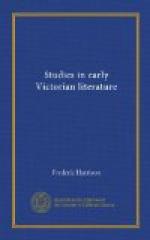The Mill on the Floss must always be very interesting to all who knew George Eliot and loved her work, if for no other reason, for its autobiographic and personal touches and its revelation of yearnings and misgivings hardly suspected in life. There are scenes and minor characters in it which hold their own against Adam Bede, but as a whole it is not so strong or so rich in colour, and it can hardly be said to occupy new ground. It has not the pathos of Amos Barton, nor the exquisite style of Silas Marner, nor the breadth and constructive merit of Adam Bede. And except to the chosen band of Eliotists, it is not likely to retain any permanent popularity. It is a book to study for those who have special interest in George Eliot as woman, as teacher, and as artist—but for my own part I find it rather a book to reflect upon than a book to read and to re-read.
With respect to Romola, though we must all agree with Mr. Oscar Browning that it is “replete with learning,” “weighed with knowledge in every page,” exquisite in art, and so forth, it is really impossible to call it with him “the best historical novel ever written.” Even in exact reproduction of another age, it cannot compare with Esmond, and how immeasurably as romance is it beneath the fire and movement of a dozen historical romances that one could name! The beauty of the Florentine pictures, the enormous care, thought, and reading, lavished on the story, the variety of literary resource—all make it a most memorable work, a work almost sui generis, a book which every student of Italy, every lover of Florence must mark, learn, and inwardly digest. But to call it a complete success is to go too far. The task was too great. To frame in a complex background of historical erudition an ethical problem of even greater complexity and subtlety—this was a task which might have sorely tried even greater powers than hers—a task in which Goethe and Scott might have succeeded, but which Goethe and Scott were too truly the born artists to attempt without ample care, and too busy with many things to devote to it the required labour.
Romola is certainly a wonderful monument of literary accomplishments; but it remains a tour de force, too elaborate, too laboured, too intricate, too erudite. As the French say, it has trop de choses, it is too long, too full, over-costumed, too studiously mounted on the stage. We sometimes see nowadays “a Shakespearean revival,” with scenery studied by eminent artists on the spot, costumes archaeologically accurate, real armour, “properties” from famous collections, a mise-en-scene of lavish splendour and indefatigable research—and then we ask, how can “Hamlet” or “Lear” live up to such learning, and why is “Romeo” such a melancholy devil? Few men enjoyed the earlier portions of Romola more than I did. Italianissimo and Florentissimo as




